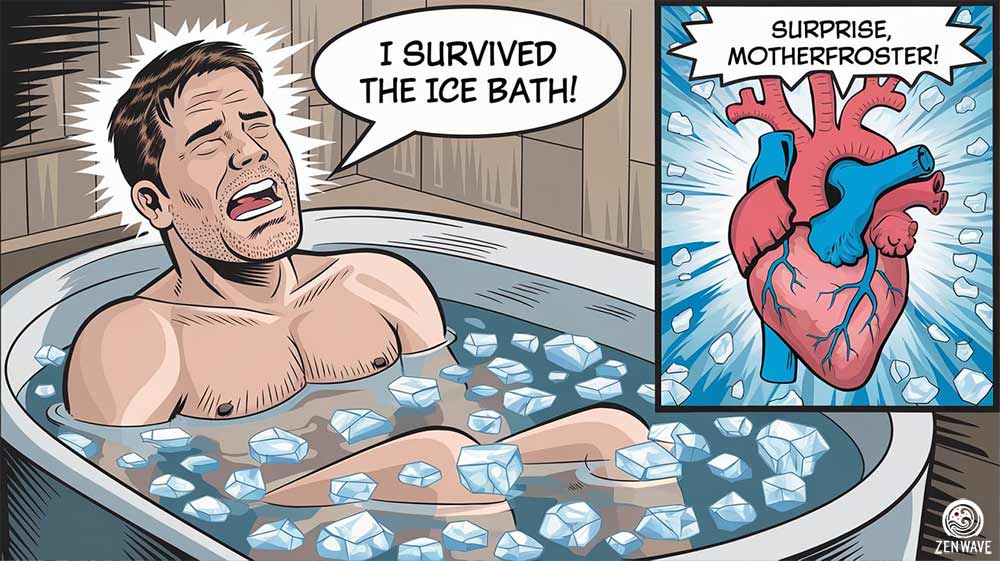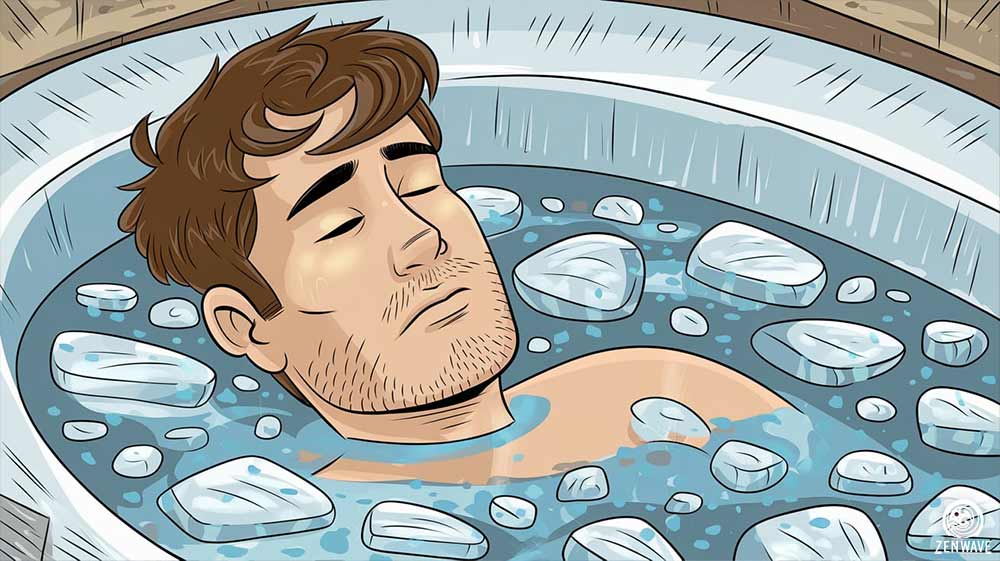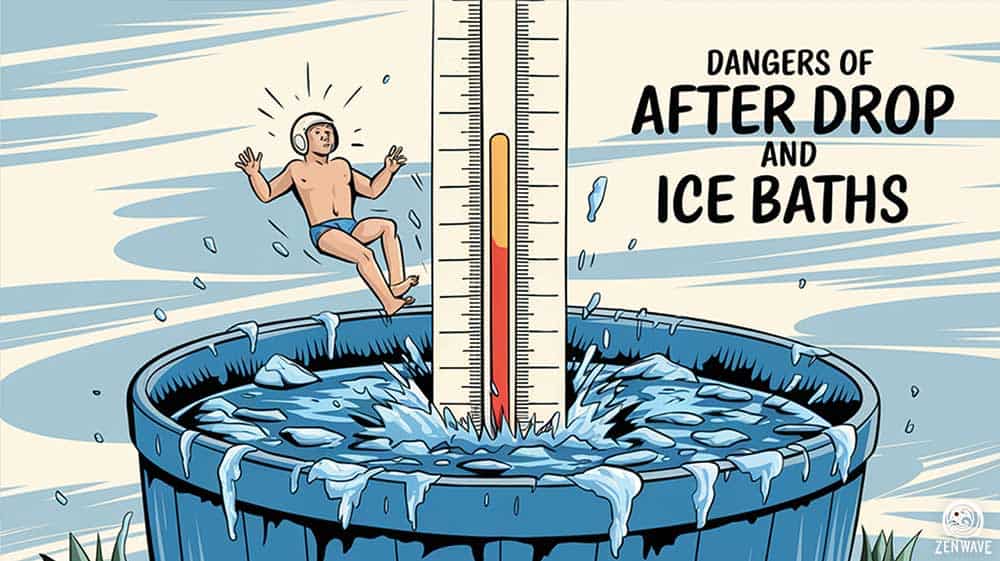Ice baths have surged in popularity for their potential benefits, but they come with a lesser-known risk: after drop. This unexpected cooling of your body’s core temperature can occur even after your done with your ice bath and trying to warm up, potentially leading to intense shivering, mental fog, or in extreme cases, hypothermia.
Understanding the connection between ice baths and after drop is crucial for safe and effective cold therapy.
We’ll explore what after drop is, why it matters for ice bath users, and how to manage it effectively, ensuring you can harness the benefits of cold exposure while minimizing risks.
What is After Drop?
After drop, sometimes called afterdrop, is a phenomenon that occurs after cold water immersion, like an ice bath. It’s when your body temperature continues to fall even after you’ve left the cold. This unexpected cool-down usually happens within 10-40 minutes after you’ve dried off, and its effects can range from vigorous shivering to mental fog, or in extreme cases, hypothermia.
So why does this happen? There are two main reasons:
- Your blood vessels tighten up: When you’re cold, blood vessels near the skin constrict to conserve heat, limiting blood flow to the extremities.
- Your body plays temperature catch-up: Once you’re out of the cold, blood flow increases to the cooled skin and extremities. This circulation brings cold blood back to the body’s core, causing the core temperature to drop further.
Important things to know about after drop:
- It can sneak up on you, even when you think you’re warming up
- The longer your cold exposure, the more pronounced it can be
- Everyone reacts differently – some people are more susceptible than others
- Knowing how to manage it is key to safe and effective cold therapy
Understanding after drop is crucial for anyone exploring cold water therapies. It highlights why proper technique and aftercare are so important in harnessing the benefits of practices like ice baths while keeping risks to a minimum.
After Drop and Ice Baths

Ice baths, while popular for their potential benefits in recovery and performance enhancement, create an ideal scenario for after drop to occur. The intense cold exposure during an ice bath significantly increases the risk and potential severity of this phenomenon.
Here’s how ice baths and after drop are interconnected:
- Duration matters: Longer ice bath sessions increase both the likelihood and severity of after drop. Extended exposure allows more time for peripheral tissues to cool, resulting in a larger temperature gradient when blood flow returns to these areas.
- Temperature intensity: Colder water temperatures can lead to more pronounced after drop effects. Ice baths are typically much colder than other forms of cold therapy, amplifying the risk.
- Individual variations: Factors like body composition, cold adaptation, and overall health influence how your body responds to an ice bath and its susceptibility to after drop. Individuals with less body fat may experience after drop more quickly and severely during ice baths, as they have less insulation against the cold.
- Cardiovascular strain: The sudden immersion in cold water causes a rapid increase in heart rate and blood pressure. This cardiovascular stress can persist after exiting the bath, potentially exacerbating after drop symptoms.
- Technique is crucial: How you enter and exit the ice bath can impact your risk of after drop. Sudden movements or rapid temperature changes can exacerbate the effect.
- Adaptation potential: Regular practice can help your body become more efficient at handling cold stress, potentially reducing the severity of after drop over time.
Ice baths and after drop are closely linked. Know the risks, read the next section to plan accordingly, and adjust your practice to get the most out of cold therapy safely.
Reducing Risk of Ice Bath After Drop

Before the Ice Bath
Preparation is key to minimizing after drop risk:
- Assess your health: Consult with a healthcare professional, especially if you have pre-existing conditions.
- Gradual acclimatization: Start with shorter, less intense cold exposures and gradually increase duration.
- Hydrate and fuel properly: Ensure you’re well-hydrated and have adequate energy reserves.
- Warm up: Engage in light exercise to raise your core temperature before the ice bath.
- Set up your post-bath area: Prepare warm, dry clothes and towels in advance.
- Mental preparation: Understand the process and potential sensations you’ll experience.
- Time it right: Choose an appropriate time of day, avoiding ice baths too close to bedtime.
During the Ice Bath
Proper technique during the ice bath can significantly impact after drop risk:
- Control your breathing: Practice slow, deep breaths to manage the cold shock response.
- Limit immersion time: Start with short durations (1-3 minutes) and gradually increase as you adapt.
- Monitor your body: Pay attention to how you feel and exit if you experience numbness or excessive discomfort.
- Keep moving: Gentle movements can help maintain circulation and reduce the risk of after drop.
- Focus on relaxation: Try to relax your muscles to prevent tension-induced heat loss.
- Maintain proper form: Keep your head above water and your core submerged for consistent exposure.
- Use a timer: Don’t rely on your perception of time, which can be distorted by cold exposure.
After the Ice Bath
Post-ice bath care is crucial for minimizing after drop risk:
- Exit slowly: Stand up gradually to prevent dizziness from sudden blood pressure changes.
- Dry off thoroughly: Remove all water droplets to prevent further evaporative cooling.
- Dress warmly: Put on dry, insulating layers to support your body’s rewarming process.
- Move gently: Engage in light exercise like walking or arm circles to promote circulation.
- Hydrate with warm fluids: Drink room temperature or slightly warm beverages to aid rewarming.
- Allow natural rewarming: Resist the urge to use external heat sources immediately.
- Monitor for symptoms: Be alert for signs of after drop, such as intense shivering or confusion.
Following a strategic post-ice bath warming routine is important for reducing after drop risk. These steps promote safe rewarming and reduce after drop risk.
Final Thoughts
Ice baths can be a powerful tool for recovery and performance, but they come with risks like after drop that require careful management. By understanding the physiological processes involved and following proper protocols before, during, and after your ice bath, you can maximize benefits while minimizing risks.
Remember, everyone’s response to cold exposure is unique – listen to your body, start gradually, and adjust your approach as needed.

